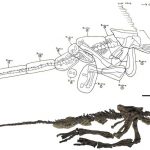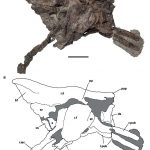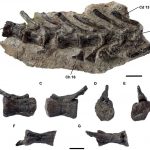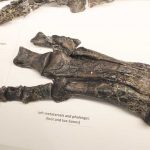










Meaning
Weald lizard
Length
4 metre (13 ft)
Classification
Ornithopoda,
Dryosauroidea Norman, 1984
Valdosaurus caniliculatus Galton, 1977
Locations
Brighstone Bay, in the plant debris beds.
A small ornithopod dinosaur, Valdosaurus had a gazelle-like lifestyle, feeding on the ferns and cycads, running away when attacked by predators. It was not always successful at this, as one specimen was found in association with Eotyrannus teeth and bones.
The main body of Valdosaurus’s ilium is low, with a wide brevis shelf, and the obturator process of the ischium is placed proximally. The femur has a pendant fourth trochanter well on the proximal half of the shaft, a deep pit medial to the fourth trochanter set well anteriorly to the shaft, a rod-like lesser trochanter separated by a deep grove from the greater trochanter, the distal end has sub-square medial edges and a deep anterior intercondylar groove that may be partly overhung laterally. The dentary has 15 teeth. The teeth are similar to those of Iguanodon, but are less leaf shaped.
Valdosaurus very similar to Hypsilophodon and Iguanodon, but can be distinguished from them as it has a curved femur, whereas Iguanodon and Hypsilophodon have straight femur shafts. The cleft separating the anterior trochanter from the greater trochanter is deeper than it is in either Iguanodon or Hypsilophodon. The fourth trochanter is more proximally situated than in Iguanodon. It had a shorter pes than Hypsilophodon, and only three functional toes.
Material is rare, so please report it if you find some…
GALTON, P. M. and TAQUET, P. 1982. Valdosaurus, a hypsilophodontid dinosaur from the Lower Cretaceous of Europe and Africa. Geobios, 15, 147-159.
NAISH, D. and MARTILL, D. M. 2001a. Ornithopod dinosaurs. In MARTILL, D. M. and NAISH, D (eds). Dinosaurs of the Isle of Wight. The Palaeontological Association. Field Guide to Fossils 10. 60-132.
